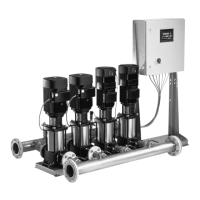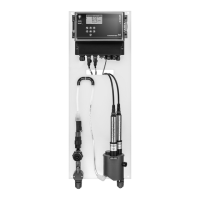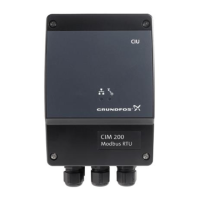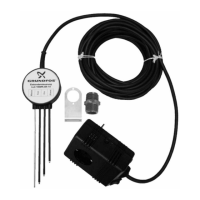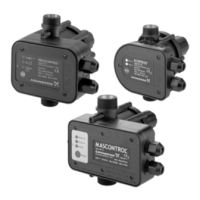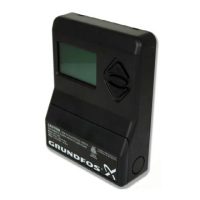27
Approximately every 30 seconds or when the operating
point changes (consumption changes), the PMU 2000 will
estimate the flow by reducing the speed for a short while.
The rate at which the pressure drops is used to compute
the flow estimate.
Systems without a PMU:
The default value for the on/off-band is 0.1 times the mea-
suring range of the pressure sensor (for example: 10 bar or
145 psi, on/off-band default is 14.5 psi).
Drawing at right illus-
trates:
Set-point (full line)
On/off-band (hatched
field)
Qmin computed by
the PMU 2000 (dotted
line)
208 - Pump Change (Rotation)
Pump rotation ensures evenly distributed running hours
for all pumps. Pump rotation is accomplished by all
Booster-paQs (PFU 2000 only and PMU 2000) by three
methods: flow demand, time-dependent, fault dependent.
Display 208 sets the time-dependent function to either
[on] or [off].
After each start or stop of a pump due to enough change
in flow demand, the PMU 2000 rotates the pump starting
order. If selected, time-dependent pump change occurs
provided the starting order has not been changed for 24
hours due to a lack of sufficient flow change or if a fault
has not occurred. Normally, flow demand will vary enough
in a 24-hour period to eliminate a time-dependent pump
change.
[on] Time-dependent pump change is active (see
Display 209)
[off] Time-dependent pump change is inactive
209 - Time for Pump Change
This display sets the time-dependent pump rotation. It is
not active unless display 208 has been set to [on].
210 - Zone Operating Parameters
Press “Enter” to move to the available zone settings (204,
205, etc. See the PMU 2000 LCD Overview Illustrations).
211 - Pump Operating Parameters
To move from Pump 1 to Pump 2 (and higher pump num-
bers), press the “DOWN” arrow while in Menu 211. Press
the “UP” arrow to move to lower pump numbers. Press
“Enter” to move to available pump settings (232, 233) for
each pump.
Notice that the temperature will most likely shoot past
the new set-point because of the 0.4 setting, but now
you will change the system time constant to 0.7 times the
measured time and the system will not overshoot. See also
Display 205.
205 - Min. Sequence (Min. Switching Time)
Another way of preventing hunting and overshoot in the
system is to adjust the minimum time between switching
individual pumps on/off (see Display 204).
The setting range is 2-300 seconds. The default value is
ten seconds. The normal range is 5 - 30 seconds.
206 - Medium sequence
(Only available when service code is entered.)
This function is like a motor minimum run timer.
Normal range: 20 - 300 seconds (default = 20 seconds).
Lower settings = more motor on/off cycling, discharge
pressure is less stable.
Higher settings = less motor on/off cycling, discharge pres-
sure is more stable.
The medium sequence is automatically and temporarily
set to one second when the discharge pressure reaches
the average of the set-point max and max limit.
The max limit can be adjusted up and down to adjust the
average to assist in the control of the BoosterpaQ. If the
max limit fault is triggered when a pump is started “across
the line,” the max limit can be adjusted to a higher value
to increase the average value.
207 - On/Off-Band
The on/off-band is the difference between the required
discharge pressure (set-point) and the stop pressure. It
can be set between 0 and the max. value of the pressure
sensor range (read the pressure sensor range on the side
of the pressure sensor). If the pressure sensor is in “bar,”
convert to psi by multiplying “bar” times 14.5 (for example:
10 bar = 145 psi).
In ME, MEH, MES, MF, and MFH systems, pump speed is
continuously adjusted to maintain constant pressure. In
MS and MSH systems, the pumps are started and stopped
to maintain the pressure.
When the flow computed by the PMU 2000 is lower than
Qmin, the discharge pressure increases to the upper limit
of the on/off-band and then stops. The stop pressure is the
selected set-point, plus the on/off-band. The system will
start again when the pressure has dropped 5% below the
set-point.

